Wakeskating's Beginnings: The Jason Messer Interview Part Three Author: Wakeskating.com Staff Author: Wakeskating.com Staff
Date:12-3-2005
To read section two, click here...
WS: So had you heard of anybody else that was wakeskating anywhere, like in Florida or California, or was it just like your own personal inspiration?
J: Yeah, that was like my own personal thing. It was like...I remember, especially in '94, I was like, gosh...it felt really special to me because I hadn’t seen it anywhere, never talked about it, and nobody’s done it as far as I could tell. It was just–everything came from me; it came from within. And that kind of inspiration is really cool, you know? It’s a little bit more of a personal pursuit, for something that’s deep within and trying to satisfy something from within--you know, invent. I just loved the inventiveness of the sport and I think that’s what a lot of people like about it right now–it’s still very inventive. There’s a lot of ways it could go. And at the time when it was first starting, imagine what I was thinking about it, just all the ways in which it could go is a really cool feeling, you know? To kind of be at the beginning of it, and it was almost kind of like you’re in on a really good secret [laughs].
WS: Yeah, even now. Seriously, I feel like wakeskating is something like 10 years old-ish and it’s still so young, and there are so many things that can be done. I haven’t been into it as long as you have, but I still feel like I’m a part of something special. It’s kind of cool because it’s not every day you get to be a part of something that young and see it grow, you know?
J: Yeah, well, a lot of people I think really like wakeskating because it’s–how young of a sport it is, and there’s so much more that can be developed. For people that like to build and invent and think and create, it’s a very good sport because there’s so much more to do in the sport. You know, it’s a perfect sport for creators, for inventors.
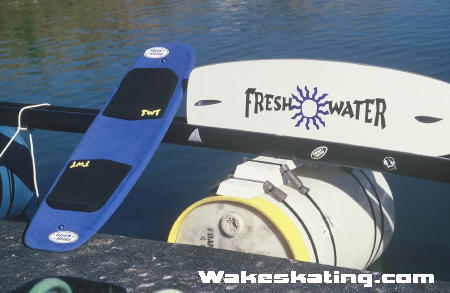
The result of passion, creativity, dedication to progression, and unwritten books.
Single Shot
WS: Yeah, not only for building but for tricks too.
J: Yeah!
WS: Since you’re not connected, there’s so much you can do and there’s so much that hasn’t been done yet.
J: Yeah, that’s what I’m talking about.
WS: When you started to do your thing with wakeskating, what were people’s reactions to it? Were people psyched on it, or...
J: Yeah, well...
WS: ...or were they baffled!
J: No, I mean, it was kind of one of those things where I was riding in the water, people wouldn’t really know because I looked like a wakeboarder at that time, because I could basically get as much air as a lot of people that were riding at that time, if not more [laughs]. And I was doing all the hand grabs and stuff so it was just kind of like they really had to look, and once they saw that I was riding without bindings they were like, “Woah. Why?” kind of, you know? “Why do that?” But that was just because wakeboarding was so young of a sport, people were just like, “Why would…shouldn’t you wait 10 years or something?” And that was kind of a little bit more of it like, “God, you know? Slow down a little bit, buddy.” [Laughs].
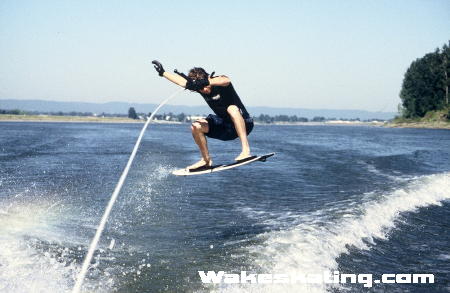
A perfectly executed wake to wake on the old FM Josh Smith and some Fresh Water pads--the set up of choice at the time. c. 1996
WS: Now, this is about that rail that you hit on a wakeskate. Do you know if you were the first guy to do any jibbing at all?
J: Oh yeah. You mean on a rail?
WS: Yeah.
J: Yeah, nobody’s ever messed around on a rail before that–not to my knowledge. The only people...I’ve never heard of anybody before that.
WS: I haven’t either, and that’s like the first documentation I’ve ever seen, too.
J: Yeah, I think so too. I think that’s pretty much...
WS: So how did you get the idea for that? Was that basically like a skateboarding-type influence?
J: Um, yeah. Like riding rails, that just seemed like a natural progression for the sport. And... I think it was like McCaffray called me in November of '97 or something and said that he was gonna be running an article in Wakeboarding magazine, and he wanted wakeskating photos.
And my friends, Derry Malloy and Tom Van Arsdale...Tom runs a ski school out of lower Castaic Lake and Derry is his real good friend, and Derry was my really good friend at the time. And Derry had really been into wakeskating, and I had been down there hanging out with him and talked to him all the time. And they had been saying that they wanted to get a floating rail together, and Derry had all of the barrels for it, you know, all these big barrels.
So when Bill said he needed wakeskating photos, it was already November and I was up in Portland. So I was thinking, man, I need to get down to Southern California to ride for these photos. And not only that, but I need to get that rail together, too, so I could do some rail sliding, and that would be really good for wakeskating. And so I called up Derry and I was like, “Derry, I want to come down there like next weekend. I need you to get all those barrels together, and get some PVC pipe together, and I’ll be down there and we’ll build it.” He was like, “Hell yeah, let’s do this!”
So like next weekend I flew down there and--maybe even that weekend, I don’t know. I just knew it was fast. I remember getting down there and being like, you know, Derry had like eight barrels together and a bunch of PVC pipe, and just some other random things. I don’t know, it came together pretty fast. We just started that night on building it and I got this banding machine, and we just did what it took to get this slider together. And I think by the next day we had a 40 foot slider that was ready to float. We just put that thing on the water and...[laughs] I don’t know, that thing was pretty sketchy at first because it was like seven barrels long. I think they were like 70 gallon barrels or whatever. And we anchored them down pretty good but it still was like, it kind of felt like a snake or something when you got on it, because it just wanted to go every which way. I’m pretty good with rails so we hit that thing up first time, and I think I hit it 50-50 and crossed basically the whole thing and…
WS: So you basically got it all on your first hit?
J: On my first hit I got on that rail 50-50 and got almost the whole way over that rail. And then I remember at the very last like, getting pitched off the front of the board and sliding the last 10 feet on my back on the rail and then landing in the water, and I was like, “Oh, this is so on!” And then I was kind of like, I almost couldn’t believe that I buttered it that good. I don’t even know...it was probably just me that fell, but whatever.
Yeah, then we just circled around a couple more times and then I started to boardslide it, and then it started getting way easy. And then I really started trying to get some nice boardslides down, you know, that would look good in photos. I’m like, “Okay Derry, let’s go for it.” And then we just spent the rest of the afternoon shooting sequences.
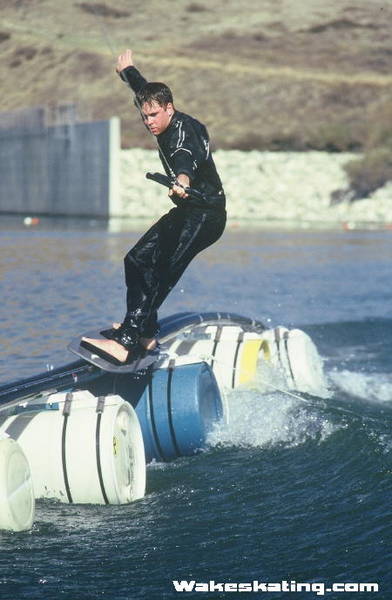
History in the making; vintage jibbing session from c.1997.
WS: Did Derry hit it at all?
J: Not that day. I have some photos from that sequence from that day, and it was really all about getting those sequences of me that day because we kind of had limited time. But it’s funny, I was looking back at those old slides a couple weeks ago and there’s a slide of Tom Van Arsdale, and it looks like he was hitting it on his wakeboard. I don’t know if I made him hit it first on his wakeboard or what [laughs]. But, yeah, that day I was the only one sliding.
WS: It’s crazy, too, when you look at the pictures of you doing that 50-50, because I think that’s what was published, to see how the barrels that you’re over are half way under water and the other ones are still kind of floating.
J: Yeah, exactly. Well, they ran that boardslide sequence when...I think it was called “Wakeskate”. I think it was a seven page story called “Wakeskate.” It was the first story Wakeboarding magazine had ever run about wakeskating with the first photos. And I think it was just called “Wakeskate” with Bill McCaffray. That sequence I have, that seven sequence photo of me doing a boardslide, that was definitely from that day, too.
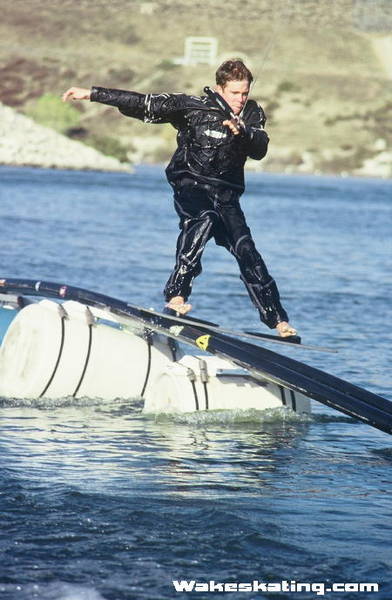
A wakeskate boardslide, utilizing the the control points of the FWT. (Check out the toes!)
WS: You’re right, I forgot about that. The one that’s burned in my head is that 50-50 where you’re looking at the camera.
J: Yeah, that was gnarly! They ran that about a few months later. Yeah, I think that that photo right there converted a lot of people, or made a lot of people think, “Hmm, this is something. This is something good.”
When and where did it take place exactly?
J: That rail slide we floated at Lower Castaic Lake and that’s in Southern California, which is outside of LA. And that would have been...the date on the slide was November 29th, 1997.
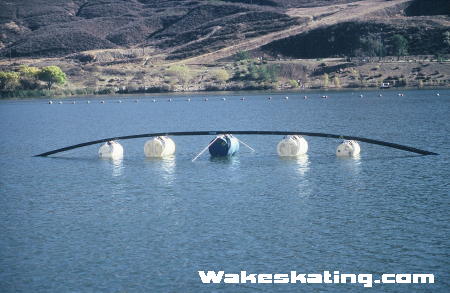
What more needs to be said? Legendary rail...
WS: Awesome. And the other people that were involved with it were Tom Van Arsdale and Derry Malloy?
J: Yeah, Tom was driving and Derry was snapping photos.
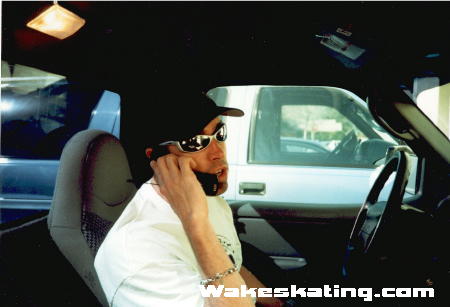
This is a shot of the quintessential Derry Malloy. The way he's remembered: shades, a cell phone to his ear, and a giant mug of Mountain Dew near by.
To read section four, click here.
Shop For Wakeskating Gear 
|